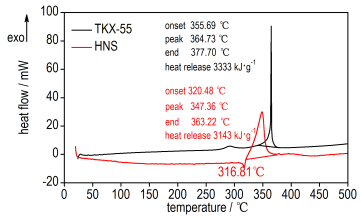2. 西北大学化学与材料科学学院,陕西 西安 710127
2. College of Chemistry & Mateirals Secience, Xi'an 710127, China
含能化合物在核武器、空间探测及深井爆破等领域需要面对高温使用环境,必须具有较高的熔点、较低的蒸汽压和良好的耐热性能,经历长时间加热后仍能可靠完成爆轰反应[1, 2, 3]。芳基稳定性高,因此耐热含能化合物骨架多为芳环结构,在此基础上通过分子设计形成多环共轭结构,利用离域能及π-π堆积作用等共轭稳定化效应来进一步增强含能化合物的热稳定性是提升化合物耐热性能的有效途径[4]。六硝基茋(HNS)中的两个三硝基苯通过乙烯基相连接形成大的共轭体系结构,具有高共轭能量和熔点,是此类化合物的代表性化合物之一[5, 6]。5, 5'-双(2, 4, 6-三硝基苯基)-2, 2'-双(1, 3, 4-噁二唑)(TKX-55)是一种具有低摩擦感度和撞击感度的新型耐热炸药,其结构与HNS相似,也含有两个三硝基苯,但中间通过两个1, 3, 4-噁二唑桥相连,共轭体系更大。研究[7-8]表明,TKX-55的密度(1.837 g·cm-3)、生成焓(197.6 kJ·mol-1)、爆速(8030 m·s-1)、爆压(27.3 GPa)均优于HNS,对摩擦钝感(> 360 N),撞击感度(5 J)和静电感度(25 J)与HNS相当。
目前,对于TKX-55的研究多集中在合成及常压下的部分热性能研究[9],而对于其高压下的热行为研究仍较为缺乏,在一定程度上限制了TKX-55的进一步应用。为此,本研究利用差示扫描量热法(DSC)和热重分析法(TG)研究了TKX-55的热分解行为,并研究其非等温热分解动力学,与目前广泛使用的耐热炸药HNS进行了对比,以期为TKX-55在含能材料领域的应用,尤其是高温高压条件下的应用提供依据。
2 实验部分 2.1 试剂与仪器 2.1.1 实验试剂2, 4, 6-三硝基甲苯,纯度99.0%,自制;HNS,纯度99.0%,自制;TKX-55,自制[9],纯度99.5%,密度1.837 g·cm-3。重铬酸钾,纯度98.0%,阿尔法化学试剂股份有限公司;草酰氯,纯度99.0%,阿尔法化学试剂股份有限公司。
2.1.2 实验仪器TG-DSC STA 449C,德国耐驰公司;实验条件:金坩埚;样品量为0.6 mg;升温速率为2.5,5.0,10.0,20.0 K·min-1;流动气氛:氮气,流速为50 mL·min-1。
3 结果与讨论 3.1 常压下TKX-55的热分解特性10.0 K·min-1常压下的TKX-55和HNS TG-DSC曲线见图 1。从图 1a可知,升温速率10.0 K·min-1时,从室温~500 ℃,TKX-55只出现一个尖锐的放热分解峰,初始分解温度为362.62 ℃,峰值温度为370.13 ℃,没有吸热熔融峰。推测TKX-55的分解反应是一个固态分解过程,在此过程中质量损失约为75%。从图 1b可知,在同等试验条件下,HNS在分解之前出现一个明显的吸热熔融峰,初始分解温度为319.81 ℃,峰值温度为351.55℃。HNS属于熔融分解,在此过程中质量损失约为63%。

|
图 1 TKX-55和HNS的TG- DSC曲线(10.0 K·min-1,0.1 MPa) Fig .1 TG-DSC curves of TKX-55 and HNS at 10.0 K·min-1 and 0.1 MPa |
上述结果表明,TKX-55比HNS具有更加优异的热稳定性。从分子结构上对比,HNS分子中间是乙烯基团,而TKX-55其结构与HNS相似,也含有两个三硝基苯,但中间通过两个1, 3, 4-噁二唑桥相连,共轭体系更大,基团配置均匀,整个分子形成大共轭体系和对称结构,有利于提高分子的热稳定性和耐热性能。
3.2 高压下TKX-55的热分解特性升温速率10 ℃·min-1,压力5.0 MPa时,TKX-55和HNS的高压差示扫描量热曲线(PDSC)见图 2。

|
图 2 TKX-55和HNS的PDSC曲线(10.0 K·min-1,5 MPa) Fig .2 PDSC curves of TKX-55 and HNS at 10.0 K·min-1 and 5 MPa |
由图 2可知,与常压状态下相比,TKX-55高压下的热分解峰更加尖锐,在5.0 MPa高压环境下TKX-55仍然保持高的热稳定性,初始分解温度为355.69 ℃,比HNS初始分解温高约35 ℃。TKX-55和HNS的分解放热量分别为3333,3143 kJ·g-1,两者释放能量相当。但是,TKX-55的热分解峰更尖锐,表明TKX-55释能过程集中,也就是说,TKX-55较HNS具有更强的能量释放能力。
3.3 TKX-55的非等温热分解动力学常压下(0.1 MPa),TKX-55及HNS在升温速率分别为2.5,5,10,20 K·min-1时的DSC曲线见图 3。从图 3可知,随着升温速率的增加,TKX-55及HNS的分解峰温均向高温方向偏移,原因是随着升温速率增大,反应速率随之增大,单位时间内放出的热量多,温差大,宏观上表现为热分解峰移向高温。在不同升温速率下TKX-55的分解峰温均明显高于HNS,表现出更加优异的热稳定性。

|
图 3 TKX-55及HNS在不同升温速率下的DSC曲线(0.1 MPa) Fig .3 DSC curves of TKX-55 at different heating rates and 0.1 MPa |
采用Kissinger[10]和Ozawa[11]方法计算热分解动力学参数:
Kissinger:
| $ {\rm{ln}}\left( {\beta /T_{\rm{p}}^2} \right) = {\rm{ln}}\left( {AR/{R_\alpha }} \right) + \left( {1/{T_{\rm{p}}}} \right)\left( {-{E_{\rm{a}}}/R} \right) $ | (1) |
Ozawa:
| $ {\rm{log}}\beta {\rm{ = log}}\left( {A{E_\alpha }/R{\rm{g}}\left( \alpha \right)} \right)-2.315-0.4567{E_{\rm{a}}}/\mathit{RT} $ | (2) |
式中,β为升温速率,℃·min-1;Tp为不同升温速率下的分解峰温,℃;A为指前因子,s-1;R为理想气体常数,8.314 J·K-1·mol-1。
由TKX-55和HNS在不同升温速率下的分解峰温,计算获得非等温热分解动力学参数见表 1。从表 1可知,两种方法的计算结果一致,且相关系数均大于0.99,表明计算的结果可信。TKX-55的分解活化能明显高于HNS。
| 表 1 不同升温速率下TKX-55与HNS的热分解动力学参数 Table1 Thermal decomposition kinetic parameters of TKX-55 and HNS at different heating rates |
为核实表 1计算结果的合理性,本研究采用非线性等转化率积分法[12]再次计算了动力学参数。通过该法获得TKX-55的分解活化能为233.71 kJ·mol-1,HNS为197.87 kJ·mol-1,TKX-55的分解活化能明显高于HNS,进一步证实TKX-55较HNS具有更加优异的热稳定性。
耐热炸药大多应用于高温高压的场景,因此,通过相同的方法研究了不同升温速率下,5 MPa高压下TKX-55的热分解动力学行为,结果见图 4。

|
图 4 TKX-55不同升温速率下的PDSC曲线(5 MPa) Fig .4 PDSC curves of TKX-55 at different heating rates and 5 MPa |
Kissinger法计算获得TKX-55高压分解活化能为239.84 kJ·mol-1。非线性等转化率积分法获得的TKX-55高压分解活化能为240.07 kJ·mol-1。与常压分解反应的活化能233.50 kJ·mol-1接近,这表明,TKX-55在高压下分解机理与常压下近似,仍然具有很高的热稳定性。
3.4 TKX-55的热力学参数和热安全性为了获得TKX-55的热安全性参数,根据GJB772A-1997方法505.1,利用多项式回归方程Tpi = Tp0+ aβi+bβi2,得到升温速率趋向于零时的外延分解峰温Tp0=616.10 K。热力学参数计算公式为:
| $ A{\rm{exp}}\left( {-E/RT} \right) = \frac{{{K_{\rm{B}}}T}}{h}{\rm{exp}}\left( {-\Delta {G^*}/RT} \right) $ | (3) |
| $ \Delta {H^*} = E-RT $ | (4) |
| $ \Delta {G^*} = \Delta {H^*}-T\Delta {S^*} $ | (5) |
式中,kB为Boltzmann常数, 1.381×10-23 J·K-1;h为Plank常数,6.626×10-34 J·s-1;T=Tp0;R为理想气体常数,8.314 J·K-1·mol-1;A为指前因子,s-1;E为活化能,kJ·mol-1。
将Kissinger法求得的EK=233.50 kJ·mol-1、A=1016.99 s-1, 带入式(3)~(5),分别求得TKX-55的热分解反应活化熵ΔS*、活化焓ΔH*及活化吉布普斯自由能ΔG*,计算结果见表 2。
| 表 2 TKX-55和HNS的热分解热力学参数及热安全性参数 Table2 Thermodynamic parameters and thermal safety parameters for thermal decomposition of TKX-55 and HNS |
再结合Zhang-Hu-Xie-Li[13, 14, 15]公式计算热爆炸临界温度(Tb),采用公式TSADT = Tb - (RTb2/E)获得自加热分解温度(TSADT)[16]。为了便于比较,用同样的方法计算了HNS的热安全参数,计算结果也列于表 2。
从表 2可知,TKX-55的热安全性参数均明显高于HNS。相对于HNS,TKX-55耐热性能更好,具有更高的热稳定性。这可能是因为TKX-55拥有更大的共轭体系导致的。
4 结论(1) TKX-55在5.0 MPa高压状态下较之常压下的峰形更加尖锐且仍然保持高的热稳定性,初始分解温度为355.69 ℃,比HNS初始分解温高约35 ℃。同时TKX-55的分解峰形尖锐,释能过程集中,表明TKX-55较HNS具有更强的能量释放能力。
(2) 在不同升温速率下TKX-55的分解峰温均明显高于HNS,表现出更加优异的热稳定性。Kissinger法计算获得TKX-55高压分解活化能为239.84 kJ·mol-1。非线性等转化率积分法计算获得的TKX-55高压分解活化能为240.07 kJ·mol-1。与常压分解反应的活化能233.50 kJ·mol-1相当,显示TKX-55在高压下分解机理与常压下近似,仍然具有很高的热稳定性。
(3) TKX-55的热安全性参数均明显高于HNS。相对于HNS,TKX-55耐热性能更好,具有更高的热稳定性。这可能是因为是TKX-55拥有更大的共轭体系导致的。结合两者结构分析可知,扩大分子共轭体系可以显著增加分子的热稳定性。本结果为新型结构耐热炸药的设计和优化提供了新的思路。
| [1] |
Yan Q L, Zeman S. Theoretical evaluation of sensitivity and thermal stability for high explosives based on quantum chemistry methods: a brief review[J].
International Journal of Quantum Chemistry, 2013, 113(8): 1049-1061. DOI:10.1002/qua.v113.8 |
| [2] |
Nandi A K. Assay of the thermally stable, insensitive, high explosive 1, 3, 5-triamino-2, 4, 6-trinitrobenzene (TATB)[J].
Central European Journal of Energetic Materials, 2014, 11(2): 3-13. |
| [3] |
Philbin S P, Millar R W, CoombesR G. Preparation of 2, 5-diamino-3, 6-dinitropyrazine (ANPZ-i): a novel candidate high energy insensitive explosive[J].
Propellants, Explosives, Pyrotechnics, 2000, 25(6): 302-306. DOI:10.1002/(ISSN)1521-4087 |
| [4] |
张俊林, 周静, 毕福强, 等. 芳香耐热含能化合物合成研究进展[J].
含能材料, 2017, 25(10): 873-880. ZHANG Jun-lin, ZHOU Jing, BI Fu-qiang, et al. Progress on synthesis of heat-resistant aromatic energetic compounds[J]. Chinese Journal of Energetic Materials (Hanneng Cailiao), 2017, 25(10): 873-880. DOI:10.11943/j.issn.1006-9941.2017.10.014 |
| [5] |
Gilbert E E. The preparation of hexanitrostilbene from hexanitrobibenzyl[J].
Propellants, Explosives, Pyrotechnics, 1980, 5(6): 168-172. DOI:10.1002/(ISSN)1521-4087 |
| [6] |
Lu T T, Yao K, Mao Y, et al. A novel and efficient synthesis of hexanitrostilbene by N-hydroxyphthalimide/FeCl2-catalyzed aerobic dehydrogenation of hexanitrobibenzyl[J].
Journal of Energetic Material, 2013, 31(3): 217-223. DOI:10.1080/07370652.2012.710870 |
| [7] |
Klapötke T M, Witkowski T G. 5, 5'-Bis(2, 4, 6-trinitrophenyl)-2, 2'-bi(1, 3, 4-oxadiazole) (TKX-55): Thermally stable explosive with outstanding properties[J].
Chempluschem, 2016, 81(4): 357-360. DOI:10.1002/cplu.201600078 |
| [8] |
Gottfried J L, Klapötke T M, Witkowski T G. Estimated detonation velocities for TKX-50, MAD-X1, BDNAPM, BTNPM, TKX-55, and DAAF using the Laser-induced Air Shock from Energetic Materials Technique[J].
Propellants, Explosives, Pyrotechnics, 2017, 42(4): 353-359. DOI:10.1002/prep.201600257 |
| [9] |
Zhou J, Ding L, Bi F Q, et al. Research on the thermal behavior of novel heat resistance explosive 5, 5'-bis(2, 4, 6-trinitrophenyl)-2, 2'-bi(1, 3, 4-oxadiazole)[J].
Journal of Analytical & Applied Pyrolysis, 2018, 129: 189-194. |
| [10] |
Kissinger H E. Variation of peak temperature with heating rate in differential thermal analysis[J].
Journal of Research of the National Bureau of Standards, 1986, 57(4): 217-221. |
| [11] |
Ozawa T. A new method of analyzing thermogravimetric data[J].
Bulletin of the Chemical Society of Japan, 1965, 38(11): 1881-1886. DOI:10.1246/bcsj.38.1881 |
| [12] |
胡荣祖, 高胜利, 赵凤起, 等.
热分析动力学[M]. 北京: 科学出版社, 2008: 234-242.
HU Rong-zu, GAO Sheng-li, ZHAO Feng-qi, et al. Thermal analysis kinetics[M]. Beijing: Science Press, 2008: 234-242. |
| [13] |
胡荣祖, 杨正权, 梁燕军, 等. 线性升温条件下炸药热爆炸临界温度的数值解[J].
爆炸与冲击, 1987, 7(1): 348-351. HU Rong-zu, YANG Zheng-quan, LIANG Yan-jun, et al. Numerical solution of the critical temperature of thermal explosion of explosive under linearly incareasing temperature conditions[J]. Explosion and Shock Waves, 1987, 7(1): 348-351. |
| [14] |
Xie Y, Hu R Z, Yang Z Q, et al. Studies on the critical temperature of thermal explosion for 3-nitro-1, 2, 4-triazol-5-one (NTO) and its salts[J].
Propellants, Explosives, Pyrotechnics, 1992, 17(6): 298-302. DOI:10.1002/(ISSN)1521-4087 |
| [15] |
Zhang T, Hu R, Xie Y, et al. The estimation of critical temperatures of thermal explosion for energetic materials using non-isothermal DSC[J].
Thermochimica Acta, 1994, 244(244): 171-176. |
| [16] |
汤崭, 杨利, 乔小晶, 等. HMX热分解动力学与热安全性研究[J].
含能材料, 2011, 19(4): 396-400. TANG Zhan, YANG Li, QIAO Xiao-jing, et al. On thermal decomposition kinetics and thermal safety of HMX[J]. Chinese Journal of Energetic Materials(Hanneng Cailiao), 2011, 19(4): 396-400. DOI:10.3969/j.issn.1006-9941.2011.04.010 |

The thermal decomposition behavior and thermal decomposition kinetics of TKX-55 at normal pressure and high pressure were studied by thermal analysis method and compared with HNS.




